Centuries ago, long before Ladakh became a bucket-list destination for modern travelers, it was an integral part of the fabled Silk Route, the sprawling network of trade paths that connected East to West. Often referred to as the “Land of High Passes,” Ladakh’s unique location made it a critical juncture for merchants, monks and nomads journeying between the Indian subcontinent, Tibet and Central Asia.


From as early as the 2nd century BCE, Ladakh became a vital artery of the Trans-Himalayan trade, carrying Chinese silk, Indian spices, Tibetan wool, Central Asian gems and its own prized salt. But the Silk Route wasn’t just about goods, it also carried ideas and beliefs. Buddhism traveled this path from India to Tibet, taking root in Ladakh, where its spirit still lives on in the region’s monasteries, art, and way of life.
Tucked beyond the mighty Khardung La Pass, Nubra Valley once thrived as a vital Silk Route outpost. After crossing high passes, merchants paused here to rest, trade and pray before heading to Central Asia or Kashmir. With its rivers and fertile lands, Nubra offered refuge and abundance. Even today, echoes of that trading past live on in its villages, monasteries and rich traditions.
Kyagar Village: A Tranquil Chapter of the Silk Route
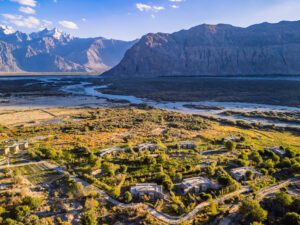

Among the hidden jewels of Nubra lies Kyagar (Tegar) Village, a serene, offbeat destination where the Silk Route’s legacy quietly lives on.
Set against a backdrop of snow-capped mountains and bordered by the winding Nubra River, Kyagar is a place where history, nature and spirituality blend seamlessly. In earlier times, this village served as a calm resting point for travelers, a space to breathe, heal and prepare for the next leg of their journey. Today, it offers the same sense of peace to those seeking an authentic Ladakh experience far from the tourist trails.
A Landscape of Stories
Kyagar’s natural beauty feels like a page from a storybook, lush valleys, shifting skies and breathtaking sunrises draw photographers, stargazers and solitude seekers alike. But beyond the views, it’s the warmth of its people that makes it special. Wander through the village, share butter tea, and listen to stories of monks, traders and ancient journeys.
Kyagar is also a gateway into Ladakh’s cultural heart. Its peaceful monastery, traditional farming, and age-old culinary practices echo influences from India, Tibet and Central Asia. Each meal, from steaming thukpa to momos, connects you to a living heritage shaped by centuries of travel and trade.
Unlike places that rush to entertain, Kyagar invites you to slow down: walk by the river, watch farmers at work and feel the wind whisper past chortens and willows. Adventurers can explore hidden trekking routes and secret sand dunes, while seekers of peace can simply breathe and reconnect. Here, you don’t just see Ladakh, you live it.
Kyagar may no longer echo with the sound of camel bells or the murmur of silk traders, but its essence remains deeply tied to that timeless era. In this quiet village of Nubra, the spirit of the Silk Route lives on, not in grand monuments, but in shared meals, local legends and the peace of the mountains.
Whether you’re chasing stories, starlight or silence, Kyagar is a place where Ladakh whispers its deepest truths, slowly, beautifully, and soulfully.
Kanggyogs-pa House
Where the Past Feels Present


In the heart of Kyagar stands Kanggyogs-pa House, a grand old house that was once a well-known stopover for travelers during the days of the Silk Route. For many years, this house remained just a quiet home, with its rich history known only to the local family. But in 2024, something beautiful happened.
A group of seven women from Kyagar, all local housewives who had rarely stepped beyond their village, came together to create something meaningful. They formed the Kyagar Women’s Group and with love and effort, they turned Kanggyogs-pa House into a special cultural experience for visitors. This wasn’t just about tourism, it was about sharing their way of life, their food and their heritage with the world.
Today, when you enter Kanggyogs-pa House, you’re not entering a museum. You’re stepping into a living home, one that breathes with stories and welcomes you like family.
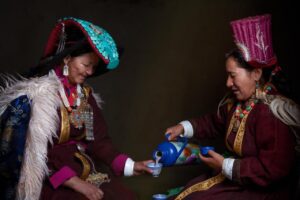

One of the most remarkable things about Kanggyogs-pa House is that it wasn’t just any home. In the old days, it was known for its royal hospitality. Traders, monks and even members of the Ladakhi royal family would stay here during their long journeys.
The house has a large traditional hall with a unique half-open roof, a clever design that lets in light and warmth. This space was once used for gatherings, ceremonies and community events. The hall was divided into two special sections: the “Deevan-e-Khaas”, where royal guests and important visitors were hosted and the “Deevan-e-Aam,” where local villagers and travelers would gather. This distinction shows how carefully the house was designed to serve people of different walks of life, everyone had a place here.
Below this hall lies an old stable, once used to keep the horses of Silk Route traders. Today, the stable still holds original saddles and travel gear.
Dining with History: Meals That Tell Stories
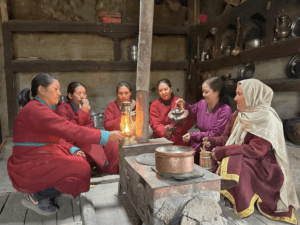

The most magical part of Kanggyogs-pa House is its food, not a restaurant meal but an experience that feels like sitting in a grandmother’s warm, story-filled kitchen.
Prepared by the Kyagar Women’s Group using age-old methods, each dish is a slice of history once shared with royals and Silk Route travelers. The kitchen itself, with its copper kettles and wooden ladles, is a living museum. You’ll savor steaming momos with spicy chutney, hearty buckwheat cake, comforting chutagi stew and Paba with Tangtur, a dish that has nourished Ladakhis for centuries. Traditional sweets and drinks like sea buckthorn juice or butter tea round it out.
Every bite here connects you to Ladakh’s past, weaving flavor, memory and tradition into one unforgettable meal.
Culture That Lives and Breathes
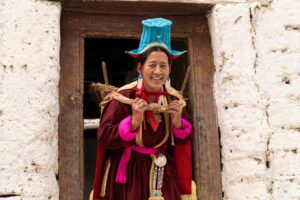

After the meal, the magic continues. Guests gather in the historic hall to enjoy vibrant group dances performed by the women, each movement telling stories of Ladakhi life, harvest, prayer and celebration. The sounds of traditional instruments and colorful costumes bring the past to life without a single word. You can also watch rare traditional skills in action, like wool spinning, barley roasting and carding by hand, crafts passed down for generations but rarely seen today. For photography lovers, every corner of Kanggyogs-pa House feels timeless, filled with soft natural light, old-world details and rich cultural attire, perfect for capturing moments that hold real stories.
Kanggyogs-pa House isn’t just a historic building, it’s a living, breathing story led by the women of Kyagar. Once confined to quiet village lives, they now proudly share their heritage with the world, inviting you not as a tourist but as a friend.
By visiting, you help preserve traditions, empower local women and support sustainable travel rooted in true connection.
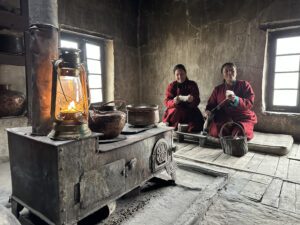

Come for the views. Stay for the story.
Kyagar may not be on every map, but that’s its magic. Here, time slows down and homes open their doors like old friends. If you love stories, food and real human warmth, Kanggyogs-pa House is waiting to welcome you.
To book your visit and experience Ladakh differently, message Mountain Homestays or send us a DM on Instagram.

